
Cheddar cheese is a natural cheese that is relatively hard, off-white, and sometimes sharp-tasting. Cheddar originates from the English village of Cheddar in Somerset.

Mozzarella is a southern Italian cheese traditionally made from Italian buffalo's milk by the pasta filata method.

Cottage cheese is a curdled milk product with a mild flavor and a creamy, non-homogeneous, soupy texture. It is made from skimmed milk by draining curds, but retaining some of the whey and keeping the curds loose. An important step in the manufacturing process distinguishing cottage cheese from other fresh cheeses is the adding of a "dressing" to the curd grains, usually cream, which is largely responsible for the taste of the product. Cottage cheese is not aged.
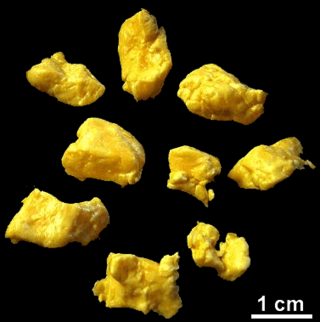
Curd is obtained by coagulating milk in a sequential process called curdling. It can be a final dairy product or the first stage in cheesemaking. The coagulation can be caused by adding rennet, a culture, or any edible acidic substance such as lemon juice or vinegar, and then allowing it to coagulate. The increased acidity causes the milk proteins (casein) to tangle into solid masses, or curds. Milk that has been left to sour will also naturally produce curds, and sour milk cheeses are produced this way. Producing cheese curds is one of the first steps in cheesemaking; the curds are pressed and drained to varying amounts for different styles of cheese and different secondary agents are introduced before the desired aging finishes the cheese. The remaining liquid, which contains only whey proteins, is the whey. In cow's milk, 90 percent of the proteins are caseins. Curds can be used in baking or may be consumed as a snack.

Mascarpone is a soft Italian acid-set cream cheese. It is recognized in Italy as a prodotto agroalimentare tradizionale (PAT).

Mizithra or myzithra is a Greek whey cheese or mixed milk-whey cheese from sheep or goats, or both. It is sold both as a fresh cheese, similar to Italian ricotta, and as a salt-dried grating cheese, similar to Italian ricotta salata. The ratio of milk to whey usually is 7 to 3.

Cheese curds are moist pieces of curdled milk, eaten either alone or as a snack, or used in prepared dishes. They are consumed throughout the northern United States and Canada. Notably, cheese curds are popular in Quebec, as part of the dish poutine, and in Wisconsin and Minnesota where they can be served breaded and deep fried. Curds are sometimes referred to as "squeaky cheese" or crottes de fromage.
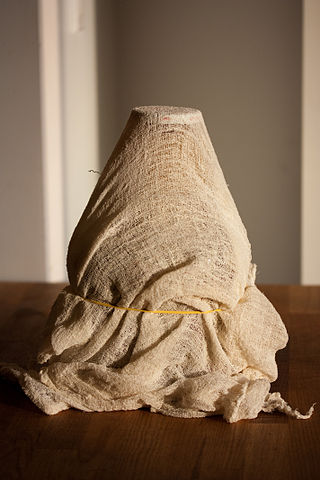
Cheesecloth is a loose-woven gauze-like carded cotton cloth used primarily in cheesemaking and cooking.

Leyden, from Dutch: Leidse kaas, is a semi-hard, cumin and caraway seed flavoured cheese made in the Netherlands from cow's milk. It is made both in factories and on farms, historically in the Leiden area.
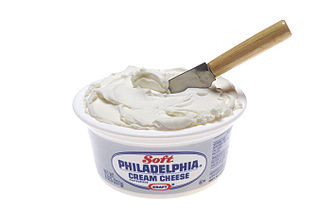
Cream cheese is a soft, usually mild-tasting fresh cheese made from milk and cream. Stabilizers such as carob bean gum and carrageenan are often added in industrial production.

Colby is a semi-hard orange cheese made from cow's milk. It is named after the city of Colby, Wisconsin, US, where it was first developed in 1885 and quickly became popular.

Cheesemaking is the craft of making cheese. The production of cheese, like many other food preservation processes, allows the nutritional and economic value of a food material, in this case milk, to be preserved in concentrated form. Cheesemaking allows the production of the cheese with diverse flavors and consistencies.

Paneer, also known as ponir, is a fresh acid-set cheese common in the Indian subcontinent made from full-fat buffalo milk or cow milk. It is a non-aged, non-melting soft cheese made by curdling milk with a fruit- or vegetable-derived acid, such as lemon juice.

Queso blanco, literally white cheese in Spanish, can refer to many different kinds of cheeses whose only common trait is their white color. The specific cheese referred to depends on the region.
The manufacture of Cheddar cheese includes the process of cheddaring, which makes this cheese unique. Cheddar cheese is named for the village of Cheddar in Somerset in South West England where it was originally manufactured. The manufacturing of this cheese has since spread around the world and thus the name has become generically known.

Époisses, also known as Époisses de Bourgogne, is a legally demarcated cheese made in the village of Époisses and its environs, in the département of Côte-d'Or, about halfway between Dijon and Auxerre, in the former duchy of Burgundy, France, from agricultural processes and resources traditionally found in that region.

Strained yogurt, Greek yogurt, yogurt cheese, sack yogurt, or kerned yogurt is yogurt that has been strained to remove most of its whey, resulting in a thicker consistency than normal unstrained yogurt, while still preserving the distinctive sour taste of yogurt. Like many types, strained yogurt is often made from milk enriched by boiling off some water content, or by adding extra butterfat and powdered milk. In Europe and North America, it is often made from low-fat or fat-free cow's milk. In Iceland, a similar product named skyr is made.
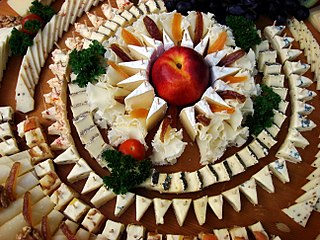
Cheese is a dairy product produced in wide ranges of flavors, textures, and forms by coagulation of the milk protein casein. It comprises proteins and fat from milk. During production, milk is usually acidified and either the enzymes of rennet or bacterial enzymes with similar activity are added to cause the casein to coagulate. The solid curds are then separated from the liquid whey and pressed into finished cheese. Some cheeses have aromatic molds on the rind, the outer layer, or throughout.
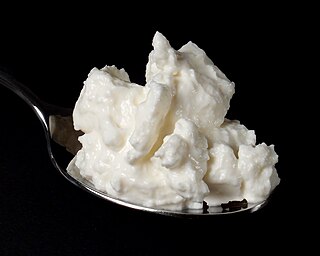
Quark or quarg is a type of fresh dairy product made from milk. The milk is soured, usually by adding lactic acid bacteria cultures, and strained once the desired curdling is achieved. It can be classified as fresh acid-set cheese. Traditional quark can be made without rennet, but in modern dairies small quantities of rennet are typically added. It is soft, white and unaged, and usually has no salt added. It is traditional in the cuisines of Baltic, Germanic and Slavic-speaking countries as well as amongst Ashkenazi Jews and various Turkic peoples.

Jāņi cheese is a Latvian sour milk cheese, traditionally eaten on Jāņi, the Latvian celebration of the summer solstice. Nowadays the cheese has become one of the symbols of Latvian culture.


















